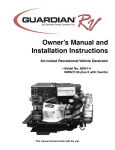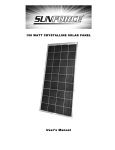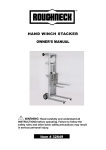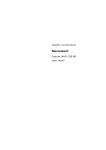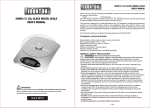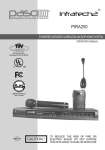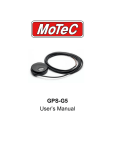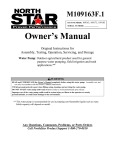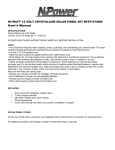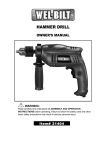Download 12 Volt 30 Amp Digital Solar Charge Controller
Transcript
12 Volt 30 Amp Digital Solar Charge Controller User’s Manual WARNING Read carefully and understand all INSTRUCTIONS before operating. Failure to follow the safety rules and other basic safety precautions may result in seriouse personal injury. ITEM# 121070 12 Volt 30 Amp Digital Solar Charge Controller Maintain 12V batteries in a fully charged state IMPORTANT SAFETY AND OPERATION INSTRUCTIONS SAVE THESE INSTRUCTIONS This manual contains important safety and operation instructions for the 12 Volt 30 Amp Digital Solar Charge Controller. Keep this manual with or near the controller at all times. The 12 Volt 30 Amp Digital Solar Charge Controller will display either the charging current or the battery voltage on the LCD digital meter. Also, LED lights will indicate the battery condition, and charge cycle status. The 12 Volt 30 Amp Digital Solar Charge Controller are designed to protect your 12 Volt Lead Acid or Gel Cell Battery from being overcharged by the solar array as well as prevent the reverse flow of current resulting in the draining of the battery during the night. The controller reduces overall system maintenance and prolongs the life of the battery. This controller is designed to work with all makes of 12 Volt Solar Panels. WARNINGS - Working with Batteries RISK OF EXPLOSIVE GAS – Working in the vicinity of a lead acid battery is dangerous. Lead acid batteries contain hydrogen-oxygen gases that can cause explosion and sulfuric acid that can cause severe burns. Always work in a well-ventilated area. DO NOT SMOKE, OR ALLOW A SPARK OR A FLAME IN THE VICINITY OF A BATTERY! Remove personal metal items such as rings, necklaces, watches, and bracelets when working with a battery. Be extra cautious to reduce risk of dropping a metal tool on to the battery. The battery may spark or short circuit. NEVER CHARGE A FROZEN BATTERY If battery acid contacts skin or clothing, wash immediately with soap and water. If acid enters the eye, IMMEDIATELY FLOOD EYE WITH RUNNING COLD WATER for at least 10 minutes. GET MEDICAL ATTENTION IMMEDIATELY. Failure to comply with above warnings may lead to explosion, and or severe injury. BE SURE TO DISCONNECT THE CONTROLLER FROM BATTERY AND SOLAR ARRAY BEFORE PERFORMING ANY MAINTENANCE OR CLEANING DO NOT DISSASSEMBLE THE CONTROLLER INSTALLATION SHOULD BE PERFORMED BY A QUALIFIED PERSON DO NOT EXCEED MAXIMUM VOLTAGE AND CURRENT RATINGS! DO NOT DEVIATE FROM WIRING INSTRUCTIONS Features • Battery Voltage Tester – Battery voltage is reflected by three LED indicator lights • Protect and maintain – Protect batteries from overcharging and maintains batteries in fully charged state • Battery Type Selector – Selection of battery type, either gel cell or lead acid, for better battery charging results • Safety circuit protection – protects against reverse polarity • Discharge protection – prevents reverse current from battery at night • Thermal protection – Overheat protection and auto resume • Terminal Block – Easy wire protection • Mounting Options – Panel or wall mounting Controller Dimensions Depth 45mm (1.77in) width 180mm (7 in) length 104mm (4.1 in) Distance between holes for mounting 164mm (6.5 in) Net weight is approximately 350g Installation Mounting - The charge controller is designed to be mounted flush with the wall. Flush mounting requires a rectangular cutout in the mounting surface with sufficient space (2-3 inches) behind to accommodate the controller and wiring. The charge controller may also be mounted to the wall without making a cutout. The controller will be raised from the wall; this is the quickest and easiest mounting procedure. CONNECTION DIAGRAM Connection Procedures (please refer to the connection diagram above) 1. Once the controller has been properly mounted select either Lead – Acid or Gel – Cell Battery modes, (refer to label below). Caution: Do not attempt to change the battery type selector switch during charging, doing so may affect the LCD meter reading. 2. Connect the solar panel positive side to the charge controller “ARRAY” positive (+) with a suitable wire. Be careful not to short circuit the solar array. 3. Connect the solar panel negative side to the charge controller “ARRAY” negative (-) with a suitable wire. 4. Connect the battery positive side to the charge controller “BATTERY” positive (+) with a suitable wire. 5. Connect the battery negative side to the charge controller “BATTERY” negative (-) with a suitable wire. Please pay close attention to the following wire specifications Wire Size Refer to the “WIRE SIZE” chart below to determine the minimum size wire needed for each connection. When using heavy stranded wire, you may need to divide the ends into two groups and straddle the screw on the terminal block. WIRE SIZE Length of Wire AWG Battery Connection Distance Round Trip Solar Array Connection Distance Round Trip not more than 0.6m (2ft) 6 or 8 6m (20ft) 10 9m (30ft) 8 12m (40ft) 6 Wire Type It is better to use a stranded wire than a solid wire. Stranded wire does not fatigue and cause loose connections over time as easily as solid wire. Use red wire for positive (+) and black wire for negative (-). One 6 AWG wire (stranded) or two 8 AWG wires are suitable. It is best to connect the wires to the controller using crimped connectors. Ensure tight connections. Any variation of wire size or length will affect the performance of the charge controller as well as the LCD display. Operation Once properly mounted and connected the charge controller will start charging immediately given adequate solar power. The 12 Volt 30 Amp Digital Solar Charge Controller is based on a three stage charging algorithm, Bulk Charge Mode, Constant Voltage mode and Float Mode. During charging period you may select the LCD meter to read either the battery voltage or charging current at any time. Battery condition is indicated by the LED lights. The controller will indicate the battery condition in three states: GOOD (green), FAIR (yellow), LOW (red). Please refer to label. Please note the charge controller is not able to start the charging process if the initial battery voltage is less than 5 volts (+/- 0.3). Monitoring LED Indicator lights – please refer to label. The top 3 LED indicator lights show the charging status of the charge controller. LED (red) indicates solar power available The ON: indicates solar panel properly connected and solar power supplied within normal expectation. OFF: indicates no power available or insufficient voltage to activate controller. The LED (blue) indicates the charge controller is in “Bulk Charge” mode LED (green) indicates “Charge Complete” at this point the battery is fully charged The and the charge controller is in float mode. Status Bulk Charge Solar Power Weak Float Charge Mode Bulk Charge LED Charge Complete LED ON OFF Flashes OFF OFF ON Conditions Indicates the battery is charging. Power is being allowed to pass through to the battery. Indicates the solar panel voltage is too low when in Bulk Charge mode or insufficient sunlight. Indicates fully charged battery, a small charge continues to pass to the battery in order to maintain a full charge state. The bottom 3 LED indicator lights show the state of the battery. These functions are described below. The icon (green LED) indicates the battery voltage is greater than 12.5V. The icon (yellow LED) indicates the battery voltage is between 11.5V and 12.5V. The icon (red LED) indicates the battery voltage is less than 11.5V. icon will blink if battery is disconnected from the unit. The charge controller will not The function if not connected to both the battery as well as the solar array. Testing may not be performed while the charge connector is unhooked from one or both of the battery or solar array. When Solar Power is weak as well as during the night the charger will turn off the charging LED, indicating that charging status has been shut off in order to prevent the current back float to the solar panel. Back Float of current may cause serious damage to the panel. Digital LCD display meter The digital LCD meter will continuously display battery voltage or charging current. It will not display both at the same time. You may select either the Current or the Volt setting at any time. Placing the slide switch in the middle turns off the LCD display meter. Technical Specifications Parameters Electrical Normal Input (Solar Cell Array voltage) Maximum Input Maximum charging current Current Consumption when connected to 15 volt array (battery not present) Current consumption when connected to a 12 volt battery (array not present) PWM constant voltage for Gel Cell battery PWM constant voltage for Lead Acid battery Float mode voltage Battery Condition Display: LED light indicated range LOW (red) FAIR (yellow) GOOD (green) LCD Meter Accuracy DC voltage Data 17-22 volts 25 volts 30 amps maximum 35mA Maximum 25mA 14.1 volts +/-0.4 14.5 +/-0.4 13.4 +/-0.4 <11.5 +/-0.4 11.5 to 12.5 +/-0.4 >12.5+/-0.4 1.25% LCD Meter Accuracy DC current 3% Protection: Over temperature protection engages at (stop charging) Over temperature protection resets at (restart charging) >80°C (176°F) <65°C (149°F) Operation Temperature Storage Temperature Operation Humidity Range from -5° to 50°C (23° to 122°F) from -10° to 70° C (14° to 158°F) 0 to 80% RH Maintenance The following maintenance is recommended to be performed every three months. 1. Ensure all wire connections are sound and free from corrosion. Tighten terminal block screws for both the solar array as well as the battery terminals. 2. Visual check of the solar array and battery wiring for signs of overheating, damage, and cracking. Replace any wires showing wear with new wires of the same gauge. 3. Verify each LED status to ensure match with specifications using a voltmeter. Troubleshooting Battery won’t charge: • Solar panel may be sized incorrectly. A panel with a larger output is required. You may add on to existing panels by wiring the additional in parallel with the existing panel. • Usage may be too high. The battery is being drawn upon at a faster rate than the panel is able to produce. A secondary battery may be used, by physically switching the batteries out and allowing one battery to supply power while the other is being charged. • Battery may be too small. In this case it may appear the battery is not charging however it is the reserve that is depleting too quickly. A battery with a larger capacity may be required. A secondary battery may be used, either by physically switching the batteries out and allowing one battery to supply power while the other is being charged or using a battery isolator. A second battery may also be added to the existing battery by wiring the additional battery in parallel to the existing battery. The charge controller need only be connected to one of the batteries in this case. • The battery may be bad. Small level of charge or discharge will greatly affect the battery voltage. Battery needs replacing. • Wires may be incorrectly hooked to the charge controller. Ensure the wires are connected in parallel to the controller and to the correct terminals. Solar Panel has no output: • The solar panel may be seriously affected by the angle of the panel with regards to the sun, and environmental factors. Ensure the surface is clean and free of dust and build up; a clean damp rag may be used to clear the panel of dust. Do not use soap or solvents of any kind. Cloudy conditions will affect the output of the solar panel. • Wires may be incorrectly hooked to the charge controller. Ensure the wires are connected in parallel to the controller and to the correct terminals. Please refer to the Connection Procedures portion of this manual. Warranty This product is covered by a 2 year limited warranty. N’Power Product's will warrant to the original purchaser that this product is free from defects in materials and workmanship for the period of two years from date of purchase. To obtain warranty service please contact N’Power Products for further instruction, at 1-800-2225381. Proof of purchase including date, and an explanation of complaint is required for warranty service. Distributed by Northern Tool + Equipment Company 2800 South cross Drive Burnsville, MN 55306 www.northerntool.com (04_22_10)








